Posted by Stephen Louw on 11-21-2004 01:31 AM:
Middle Amu Darya weaving
I am trying to focus my collecting instincts on rugs from the middle Amu
Darya region, especially their main and long carpets (kelleh) which, in my view,
offer a fascinating mix of urban and rural influences, incorporating creatively
various Central Asian, Chinese and Persian aesthetic influences. Clearly the
products of fairly established weaving settlements (the size alone suggests
this) and, in all likelihood, woven with an obviously commercial intent,
collectors do not always appreciate these rugs, which are sometimes even –
horror of horrors – catalogued as decoratives!
I like them though, and am
especially pleased to have had the chance to acquire this piece, which, despite
its obvious condition problems, is a reasonable example of the
“compartmentalised tarantula design” (my term). The drawing is freer and more
quirky than the one illustrated in Jordan’s book, and the colours are fabulous.
I am away from my books, and cannot think of other published examples
offhand.
There is some cotton in the pile, asymmetric knots open to the
right. Size: 289 cm x 136 cm (9’6” x 4’5”).
The person from whom I
bought the carpet suggests that the weave is Kirghiz and there are some Saryk
elements in it. Neither of these strikes me as likely, and I am inclined to
attribute it generally to its place of origin, the Amu Darya region, or, for
convenience, the term widely adopted in the market, Beshir.
What do you
think?
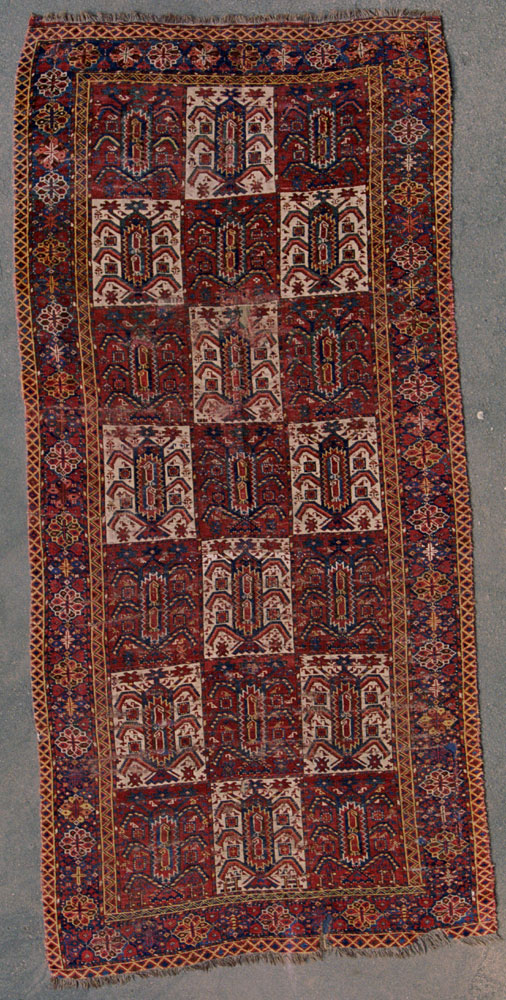
Detail:
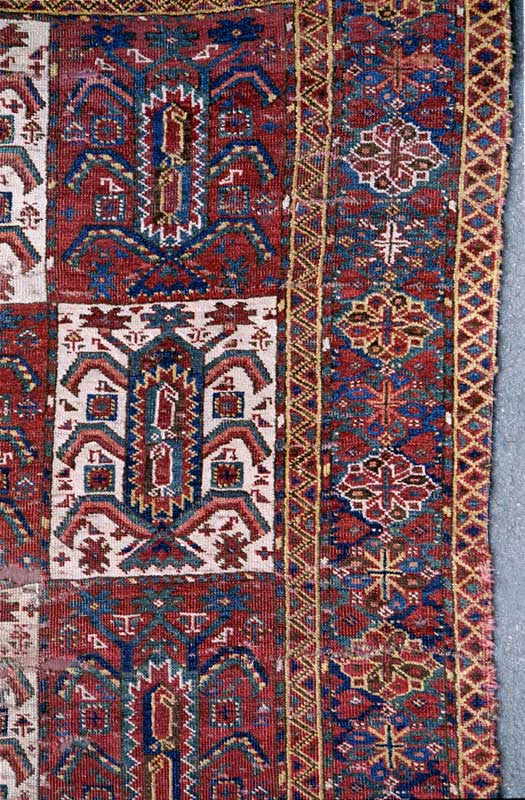
__________________
Stephen
Louw
Posted by Steve Price on 11-21-2004 09:19 AM:
Hi Stephen
In simpler times, not so many years ago, we would have all
agreed that it is Ersari. Today we know enough to be confused.
Whatever
the weaver's home, it has terrific colors.
Regards
Steve Price
Posted by Filiberto Boncompagni on 11-21-2004 10:35 AM:
Hi Stephen,
You are right, in spite of its condition your rug looks
better than the one in Jordan’s book.
Congratulations,
Filiberto
Posted by Itzhak Mordekhai on 11-21-2004 01:23 PM:
What does it do to your heart.
Hello Stephen,
Since my last thread on Karakalpak or Uzbek, my
long-held conviction has only been strengthened: What is REALLY important about
a rug is what impact it has on your heart, whether it races faster every time
you lay your eyes on it, or not. The question of origin, although academically
challenging, is less significant.
Congratulations for a fantastic carpet.
It's a knockout!
Regards,
Itzhak
Posted by Chuck Wagner on 11-21-2004 06:14 PM:
Bugs ?
Hi Stephen,
Nice rug (read that with a slightly jealous tone...)
!!
Since you're away from your books, here's the image that Filiberto
mentioned; it's from Jourdan's Turkoman volume:
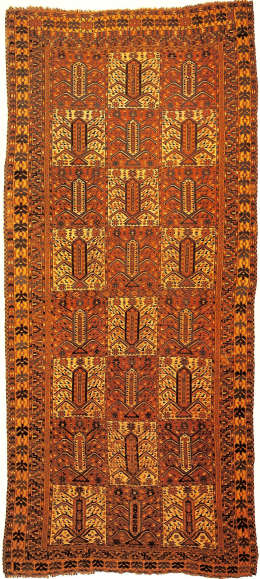
He mentions that, in the
trade, they're referred to as "Tarantula Beshirs", but states "this description
is unlikely to have anything to do with the meaning or derivation of the
principal motif." and goes on to relate it to a specific design group (unnamed,
oddly) Caucasian rugs.
He notes that the image does not do justice to the
blues in the actual piece; yours certainly has a nice combination. The border on
yours is quite typical for Bokhara workshop goods often marketed as Beshiri
pieces.
Cheers,
Chuck
__________________
Chuck
Wagner
Posted by Stephen Louw on 11-23-2004 05:57 AM:
Thanks all. Can anyone refer me to any other published examples? I know I
have seen them before, I just cannot remember where.
Posted by Filiberto Boncompagni on 11-23-2004 07:15 AM:
Hi Stephen,
My only copy of Ghereh, (#23) has an article about the
exhibition “Between the Black Desert and the Red – Turkmen Carpets from the
Wiedersperg Collection”.
The article has a photo of a rug similar to
yours:
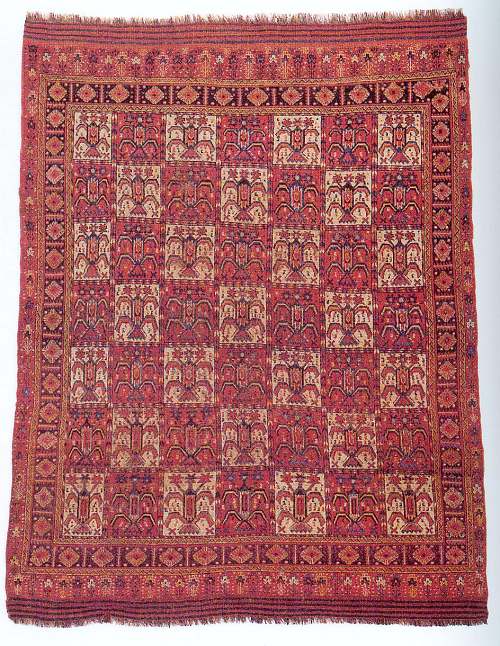
The only information about it is the size: cm 236x127, and I
doubt it is correct.
Best regards,
Filiberto
Posted by R. John Howe on 11-24-2004 08:20 AM:
Hi Stephen -
We talked about your nice piece here off board, so you
already know that I like it too. In addition, I tend to be a "sucker" in general
for compartmented designs (Rich Isaacson here, drolly suggested recently that I
should begin to "think outside the box."  ) I think the graphic impact of the
"tarantula" devices and the alternation of ground color is very
effective.
) I think the graphic impact of the
"tarantula" devices and the alternation of ground color is very
effective.
You started your first post by saying in part:
"I am
trying to focus my collecting instincts on rugs from the middle Amu Darya
region, especially their main and long carpets (kelleh) which, in my view, offer
a fascinating mix of urban and rural influences, incorporating creatively
various Central Asian, Chinese and Persian aesthetic
influences..."
Me:
This is an interesting collecting strategy.
But if I understand correctly, the usage "middle Amu Darya" here means
mostly "we can't tell what it is." Begins to resonate with earlier usages like
"Bukhara" or "Shiraz." 
I have been searching for a cluster of stable indicators being used to
signal "middle Amu Darya," but think different folks are using different things.
"Instinct" might be pretty accurate for what seems to be the current state of
affairs.
Do you have a particular cluster of indicators you use to detect
the "middle Amu Darya" pieces you seek?
Regards,
R. John Howe
Posted by Stephen Louw on 11-25-2004 08:49 AM:
John -- a good question. Would make an even better Salon!
No, I don't
have a coherent set of indicators. Ordinarily, I would have described the carpet
generically as Beshir, although this, as you know, is a very vague attribution,
as much a product of market lore as anything else. Robert Pinner had a very good
article on the subject in one of the early Hali's, in which he confessed a
similar confusion, and suggested that “Beshir” be used out of convenience (it is
well known and widely used) only.
So my use of the MAD label was meant
simply to imply a certain conceptual confusion and deliberate uncertainty. There
are a certain category of rugs, most of which appear to have been woven in
fairly established workshops, adopting deliberately Persian and Chinese motifs
and using these creatively within a largely Turkmen design vocabulary. Some of
these rugs appear to be far more sophisticated in their construction than
others.
Is that satisfactory? Not really, certainly no less so than
Pinner's use of “Beshir”. Worth thinking about!
Posted by R. John Howe on 11-25-2004 11:08 AM:
Hi Stephen -
As you no doubt know, Pinner and Elena Tsareva worked on
a book on "Beshiri" weavings for several years. Haven't heard anything about it
for quite awhile.
Likely it stalled as Pinner's health
declined.
Maybe Elena will complete and publish it now. I'll ask her if I
get a chance.
Regards,
R. John Howe
Posted by Jerry Silverman on 11-27-2004 05:20 PM:
On the way to looking up something else, I stumbled across this plate in
Jenny Housego's "Tribal Rugs" (plate 81). Her description is as
follows:
"Pile Rug: Kurds of Khurasan. Northeast Iran. Sylized beetle
forms recall those of the Ersari tribes of Central Asia and Afghanistan. The
colours and the weave, however, are typical of the Kurds of Khurasan who have
adopted several designs along with a wide variety of their own. Characteristic
of this particular group are the gold and tomato red and the zig-zag outer guard
stripes enclosing reciprocal trefoils. Size: 2.96m x
1.58m.
Cordially,
-Jerry-
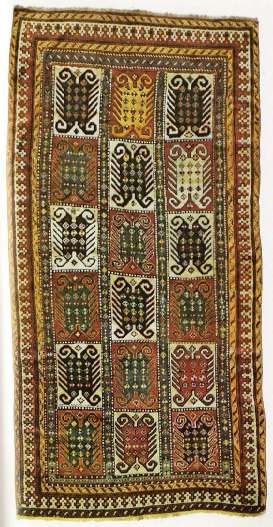
Posted by Stephen Louw on 11-28-2004 04:39 AM:
Thanks Jerry -- clear scientific evidence, based on an 100% correlation, that
neither Turkmen nor Persian weavers suffered from
arachnophobia!
Seriously, whatever these are or what they are meant to
connotate, one marvels at how universal some symbols and motifs are.
Stephen
Posted by Marvin Amstey on 11-28-2004 12:52 PM:
Here is another example of a "tarantula" from the end of a Tekke tentband
fragment shown by the Bells at the Oriental Rugs from Canadian collections II"
in 1998. It certainly looks like some type of bug to me.
 .
.
Posted by Chuck Wagner on 11-28-2004 10:43 PM:
Hi all,
This is a scan of the elem panel from a Salor ensi featured in
Jon Thompson's 'Carpets From The Tents, Cottages, and Workshops of
Asia':
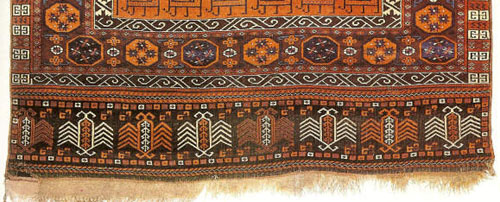
It
shares a couple of the design elements of the "tarantulas": A large central
"stalk" containing a geometric design, Legs (or wings). Although it's a stretch
to say that it resembles a bug, I can't help but wonder if the two designs might
be related at some level.
Regards,
Chuck
__________________
Chuck
Wagner
Posted by Horst Nitz on 11-29-2004 01:49 PM:
Hallo All
Whilst the first three rugs discussed in this thread all
seem closely related, plate 81 from the Jenny Housego book does not fit in.
Unlike those other examples her “stylized beetle form” has upright slanting
extremities on either side of the body and does not carry a bunch of flowers
between its jars. To me it seems more closely related to some Caucasian rugs,
i.e. plate 118 from the Karabagh area in Eder, Doris (1990) Orientteppiche, Bd.
1: Kaukasische Teppiche. This is not as unlikely a relationship as it might
seem. The Kurds of Khorassan had settled in the Karabagh region and east of
Ararat for centuries.
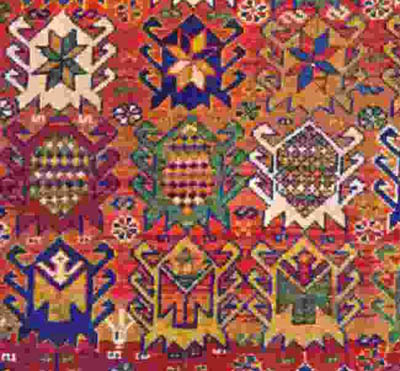
This rug displays a colour scheme one could call typical for
some rugs made by the Kurds of Khorassan.
The quite malicious looking
little beastie on the tent band of which Marvin Amstey had send us a picture is
of a quite different ilk altogether. It does not appear stylized at all but
ready to jump at anything getting near
it.
Regards,
Horst
p.s. For granted: In their daily lives
those weavers were much less occupied with heraldic shields and medaillons of
sorts than they were with beasts of the type on the tent band (had to restrain
myself not to call it lousy). Obviously, depicting them on their tent interior
must have mend to charm them away to a certain degree, as is the function of
those house demons in other cultures.
Posted by Chuck Wagner on 11-29-2004 04:49 PM:
Hi all,
Yes, Horst touches on an interesting point: the creatures
encountered in everyday life by the nomads. Indeed, the design element under
discussion reminds me of what are called "camel spiders" in the Middle East
(actually a tail-less scorpion with HUGE mandibles). Similar species are present
in Afghanistan and throughout the Turkmensahra region.
And one wonders if
the nomads knew each other by the equivalent of their high school "fighting
names", like the (I'm not making this one up...): Battling Sand Crabs of Port
Lavaca (in Texas)... 
Regards,
Chuck
__________________
Chuck
Wagner
Posted by Jerry Silverman on 11-29-2004 06:19 PM:
...and the cheerleaders shouted: "Give me a 'C'. Give me an 'R'. Give me an
'A'. Give me a 'B'. Give me an 'S'. Whaddaya' got? Crabs! Yippee!"
Must
have been rousing.
-Jerry-
Posted by Tim Adam on 11-29-2004 11:58 PM:
Except for Marvin's tendband, I think none of these designs represent bugs.
Why would anyone want to stand on a pile of bugs? Doesn't make sense to me. I'd
find it more plausible if these design elements represented some sort of grain.
Then the first rugs presented in this thread would represent grain fields. That
would make sense to me.
Regards,
Tim
Posted by Stephen Louw on 11-30-2004 02:01 AM:
Grain fields?
I think we must be careful not to let our imagination's
run away with us here. I used the term "compartamentalised tarantula" design as
a tongue-in-cheek description only. With the exception of the tentband fragment
posted by Marvin, which does appear to be quite literal in its representation of
an animal form, I personally am happy to leave it at that.
__________________
Stephen
Louw
Posted by Patrick Weiler on 11-30-2004 02:58 AM:
Can't see the wheat for the trees.
Stephen,
I suspect you are correct with your opening statement about
these Middle Amu Darya weavings, they offer:
"...a fascinating mix of
urban and rural influences, incorporating creatively various Central Asian,
Chinese and Persian aesthetic influences"
Tim suggests wheat as the
source for the design of your exquisite acquisition. My leaning is towards
trees. Bakhtiyari garden carpet trees as seen in this rug on the Jozan
website:
http://www.jozan.net/billeder/Bakhtiari1/Bakhtiar_BostonGalleries.JPG
In
both outer columns of panels, the second and sixth rows show a design quite
similar to yours. It is a tree with the same type of hexagonal trunk and these
have three white branches coinciding with the branches on your trees.
The
Bakhtiyari branches do not droop as yours do, but the basic design elements are
the same.
And, just as Indian carpets took on Persian designs, these Middle
Amu Darya designs may also have been significantly influenced by classical
Persian designs such as the compartmented garden design.
The colors in
your rug are spectacular. If you run out of room to display it, send it to
me!
Patrick Weiler
Posted by Steve Price on 11-30-2004 08:52 AM:
quote:
Originally posted by Stephen Louw
I think we must be careful not
to let our imagination's run away with us here.
Hi All
I think Stephen's point here is right on the
money and important. These motifs (and others, of course) have origins buried in
the dustbins of time and are probably beyond being knowable. Speculation on what
they represented once upon a time can be fun, but it usually leads to long
diversions that end up going nowhere. This is especially true for Turkmen
motifs, about which there is probably more nonsense written than those of any
other group.
The ones under consideration look sort of like crawling
insects (especially Marvin's), arachnids, fields of plants, trees, Viking ships,
back to back horses or other animals, butterflies, birds, TV antennas,
flowerpots with latchhooks for fastening to a window sill, graveyards, rows of
telegraph poles; the list can go on forever. Without a firm basis for deciding
which, if any, is correct, debating what it is that they most nearly resemble is
unproductive.
Regards
Steve Price
Posted by Tim Adam on 11-30-2004 10:01 AM:
Hi Steve,
I agree that design interpretations are highly subjective
and can rarely be proven. So there is usually no point to insist on a particular
interpretation. But I think that one can destinguish between the plausible,
unplausible, and the absurd.
For example, the ubiquitous 'crab border' in
Caucasian rugs has nothing to do with crabs at all, as better drawn examples
show. I feel it is worthwhile to point this out.

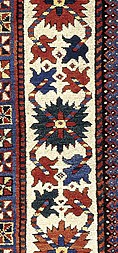
Tim
Posted by Steve Price on 11-30-2004 10:46 AM:
Hi Tim
You're right about the "crab" border, of course. Like most
motifs with unambiguous identities, it is clearly floral. People seem to hate
that reality - flowers fuel our fantasies so much less effectively than sacred
birds, scary crawling things, etc.
quote:
Originally posted by Tim Adam
...design interpretations are
highly subjective and can rarely be proven. ... But I think that one can
destinguish between the plausible, unplausible, and the absurd.
We can do the triage that you suggest, and eliminate
certain alternatives as implausible or absurd. But the list that remains is
usually still very long and it would be foolish to think that it contains all
the plausible alternatives.
Some even ignore the interpretations that
seem most obvious, preferring to pursue their fantasies. One example that comes
to mind is the so-called kejebe design used by most or all Turkmen groups. One
self-proclaimed expert on Turkmen stuff claims to have been pondering its
meaning for many years. The Turkmen call it "kejebe", which is the tent-like
affair atop the bridal camel in a wedding procession, in which the bride is
enclosed. That's either a good hint or a big red herring.
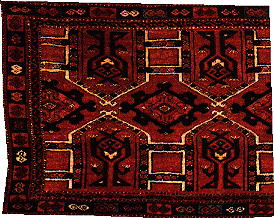
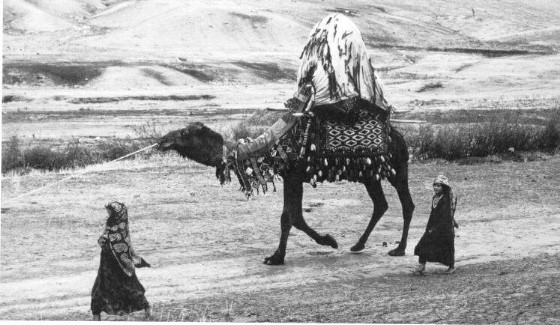
This doesn't prove that the
design represents a kejebe, but it seems unlikely that anyone will be able to
generate a better evidence-based explanation by pondering the matter.
Regards
Steve Price
Posted by Chuck Wagner on 11-30-2004 12:20 PM:
Hi all,
I was serious when I suggested that the design on Stephen's
rug might be a graphic representation of the "tribal nickname" of the weavers
tribe. Bug or not, it's certainly a reasonable suggestion.
Central Asian
tribal names such as Kizl Ayak (red-footed), Firoz Kohi (blue mountain), or Kara
Koyunlu (black sheep) have no possible connection to Apache tribal names like
Jicarilla (little basket) or Chiracauha (great mountain) or Mimbrenos (willow
people). Yet each nomadic culture has derived tribal etymologies from similar
roots. Such "tribe : observed characteristic" associations must
also work their way into pictorial tribal art.
The design is fairly
uncommon among the Turkoman rugs extant today, but it may well be a form of
tribal gul that departs from the typical polygonal designs. It seems a little
odd to me that Turkoman tribes would be weaving odes to corn or grain harvests;
farming wasn't really their strong point. But I agree that it's a
possibility.
The bug on the tent band is obvious; there is a similar,
somewhat less obvious form of bug that is seen on some Baluchi
weavings:
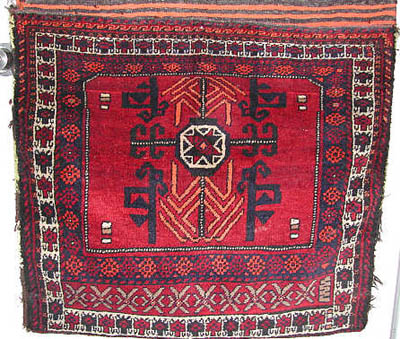
Both bear a strong resemblence to what Persians and Turks call
carpet beetles, and what the Egyptians revered as the scarab beetle. What I find
most interesting about the "band bug" is that it is one of the very few
well done Turkoman animal drawings I've seen.
Regards,
Chuck
__________________
Chuck
Wagner
Posted by Steve Price on 11-30-2004 12:50 PM:
Hi Chuck
You wrote, "tribe : observed characteristic"
associations must also work their way into pictorial tribal art. That's
undeniable, but it isn't the same thing as being able to identify the meaning or
basis of those characteristics. Maybe that thing is an insect, maybe it isn't.
Maybe it's related to carpet beetles or scarabs, maybe not. Maybe it represents
something else, maybe it's an abstraction (that is, it may not even be
pictorial). I don't know of any basis on which to make a judgment about what it
is or even whether it is representational.
Just to muddy things,
consider the design on your bagface. There are people who will read the heavy
lines in the lower part of the field as riverboats, others who will see the pale
red lines at the top and bottom of the field as women giving birth, or the pale
red lines and center device as a seated noble or god. The elements projecting
laterally from the center device will be read by some as bows and arrows. None
of these is absurd or implausible, but the list can become so long as to render
the exercise pointless.
The problem is, we have no way of knowing which,
if any, of these reflects the truth as seen by the weaver and her community.
Regards
Steve Price
Posted by Chuck Wagner on 11-30-2004 12:58 PM:
Hi Steve,
I'm surprised you didn't notice the Yomud border along the
top edge...
By the way, no thoughtful speculative inquiry is
pointless. Many are fruitless, however.
__________________
Chuck
Wagner
Posted by Steve Price on 11-30-2004 01:16 PM:
Hi Chuck
You're right- there is a difference between something being
pointless and something being fruitless. I used the wrong word. Fruitless is
better and more accurate.
The border at the top is not only common among
the Yomud, it's also almost universal in Caucasian soumak rugs. It's clearly a
representation of the coat rack at the entrance to the tribal community
bathroom.



Regards
Steve Price
Posted by Jerry Silverman on 11-30-2004 04:32 PM:
Dear Steve,
Nice interpretations!
Can you send a little of what
you've been toking out here?
Cordially,
-Jerry-
Posted by Tim Adam on 11-30-2004 09:06 PM:
Please correct me if I am wrong. I thought there are two 'types' of Turkmen,
true nomads, and those that were more settled, and pursued some limited farming.
In addition there were Turkmen living in cities, like Bokhara. Those city
dwellers are quite likely to have engaged in
agriculture.
Regards,
Tim
Posted by Chuck Wagner on 11-30-2004 10:19 PM:
Hi Tim,
It's my understanding that there have always been some crop
growing settled nomads around the Central Asian oases. And, following the
massive displacements of the Turkmen tribes by the Soviets and the associated
collectivization of farming, even more formely nomadic people settled into at
least a partially agrarian lifestyle.
So it's not inconceivable that
we're looking at the Central Asian equivalent of a Harvest Quilt. It seems like
we're converging on the text of a question for John to ask Elena Tsareva: Has
she seen evidence of agrarian symbolization in Turkoman or other Central Asian
woven goods ?
One would think that there would be less commonality
between designs if these were one-off home woven "harvest" pieces. Having said
that, we certainly haven't seen very many pieces with this
motif.
Regards,
Chuck
__________________
Chuck
Wagner
Posted by Marvin Amstey on 12-01-2004 02:40 PM:
Agrarian motifs are well known in "Ersari" weavings. They are probably from
settled folks, and their old examples are in great demand and scarce. I refer to
the "Beshir prayer" rugs with all the hanging pomegranate fruit.
Posted by Louis_Dubreuil on 12-01-2004 02:56 PM:
In the last Hali issue (137/ page 83) there is a Josheghan silk rug, central
Persia, circa 1800 (145X173 cm), private collection, Austria.
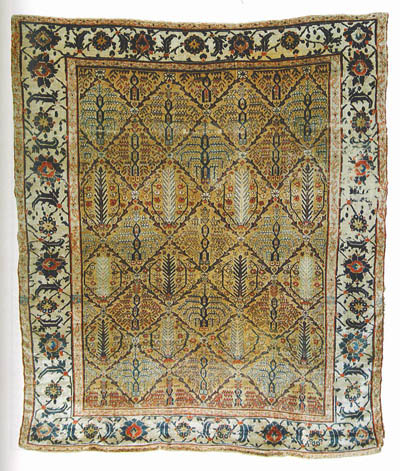
The field of this rug shows
a diagonal lattice with alternated palmettes and "shrubs". Those "shrubs" look
like the "tarantula" devices of the Beshir rugs. This phenomenon is quite
current: same motives can appear under "floral" forms or under "animal" forms.
Generally, "animal" forms are encountered among the tribal works while "floral"
forms often correspond to urban and workshop weavings. All the question is to
know what is the original form, animal or floral? Who has copied
who?
Meilleures salutations à tous
Louis Dubreuil
Posted by Filiberto Boncompagni on 12-02-2004 05:24 AM:
Hi Louis,
The general idea is that tribal weavings were influenced by
urban and workshop ones, not the other way
around.
Regards,
Filiberto
Posted by Stephen Louw on 12-02-2004 10:16 AM:
Hi
Even assuming that it is correct to use the term "tribal" to imply
somehow less developed, less settled, less urban -- and that strikes me as
something one would read in an anthropological text written during the British
Raj, and I doubt that any contemporary anthropologists would accept this usage
at all -- I see no reason why the interaction between town and countryside would
not be a reciprocal one. Are less-settled people any less creative and willing
to adapt than more settled people? Perhaps they are sometimes more resistant to
change, but that strikes me as a relative distinction at best, not a
rule.
Stephen
Posted by Steve Price on 12-02-2004 10:36 AM:
Hi Stephen
Unfortunately, the word "tribal" in Rugdom is often used as
a synonym for "nomadic". Even "nomadic" is often an incorrect descriptor of some
of the weaving groups to which it is applied.
We're unlikely to be able
to change this, although it's worthwhile reminding each other of the facts from
time to time.
Regards
Steve Price
Posted by Filiberto Boncompagni on 12-02-2004 01:17 PM:
Hi Stephen,
Personally, when I use the terms Tribal, or
Cottage, City-Workshop and Court carpets I have in mind Jon
Thompson’s framework (see his book “Carpets From the Tents, Cottages and
Workshops of Asia”) and I assume that most of our participant do the same… No
anthropology involved.
quote:
I see no reason why the interaction between town and countryside would not be
a reciprocal one
With regard to this, the same Jon Thompson wrote a convincing
argument in the above mentioned book, chapter six (Court Carpets), second
paragraph.
I’ll copy it here for the ones that don’t have
it:
Court styles and their influence
The rulers of the
great Islamic courts of the sixteenth and seventeenth centuries were notable for
their patronage of the most outstanding artists of the day. An important element
of their patronage was the maintenance of a design atelier under the immediate
direction of the court. The court artists produced designs in a variety of media
including textiles and carpets, setting the pace for new styles and fashions.
The carpets therefore, together with ceramics, calligraphy, paintings and so on,
form part of the corpus of art produced under the patronage of the dynasty and
are named accordingly. As the ruling houses were Muslim, the carpets are, with
reason, classified as Islamic art. The workshops themselves were sometimes
staffed by craftsmen in the direct employment of the court, but more often they
acted as suppliers of goods of a standard and design specified by the royal
atelier. In this case working for the court did not preclude the makers from
engaging in normal commercial activities; nor did it prevent rival workshops
from turning out similar, less expensive items in the same style. For example, a
whole gradation of quality from the outstanding to the mediocre is seen in
carpets and textiles worked in the Ottoman and Mughal court styles. High fashion
then as now was surrounded by its imitators. More imitators copied the
imitations and so the style worked its way outwards to towns and villages far
from the capital. Women in the rural communities may never have seen the
originals, and had no access to luxurious materials, so they copied the new
style in the medium they were accustomed to. Velvets were translated into
embroidery and knotted pile work (illus. p.2O) ; luxurious carpets with silk
foundations were copied using less costly yarns. Inevitably the designs were
adapted and corrupted but they lived on to be incorporated into the folk
tradition. Here they survive in rustic form centuries after the originals have
passed out of fashion.
James Opie, in his “Tribal rugs” dedicated a
whole chapter to “Urban Influences in Tribal Rugs” producing several examples.
The first is a very telling Quashqa’i workshop rug copy of a mille-fleurs Mogul
rug. (Yes, “Quashqa’i workshop” – so, it’s tribal or not?)
As a see it, I
find highly improbable that a tribal design could have inspired a Court carpet,
although I’m open to evidence.
I think that the influence was like Thompson
describes: from the Court workshop to the City workshop, than to the village and
so on. In the process the design were, more than copied, adapted and then mixed
with tribal elements. It was more a fusion - like in certain music or food -
than a copy.
Now, it has to be seen where the “tribal” ends and the
“cottage/town workshop” starts…
Regards,
Filiberto
Posted by Wendel Swan on 12-02-2004 01:19 PM:
Lesghi star
Dear Steve and all,
The self-professed expert should compare the
kejebe design with this early re-entrant type rug in the Alexander collection,
where I believe he/she will find more correspondence than with any structure
placed on a camel or, as to the “ram’s horns”, any set of horns on any
quadruped. A saph in the T.I.E.M. also bears a close relationship.
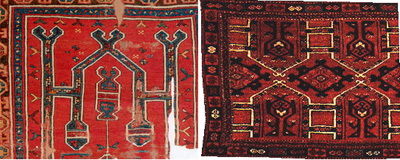
At the
moment, I can’t suggest more than that the arch form in the Alexander piece may
derive from Kufic writing or architectural motifs or even some combination
thereof. Similar devices can be found in several Seljuk carpets.
Anyone
wishing to understand the development of Turkmen designs should begin by
examining early Turkish carpets. This will not provide either definitive answers
or a time continuum, but will fill in some of the gaps.
To the notion
that we are seeing spiders, crabs, beetles and insects of one sort or another, I
give a seasonal response: Bah, humbug.
Wendel
Posted by Louis_Dubreuil on 12-02-2004 05:04 PM:
Bonsoir à tous
In Hali 99, page 128, there is a Beshir rug with the
same family design. The design can be read as a family of bugs or other animals
(look at the little bugs in the lattice bands!). But it can be also flowers or
burdocks (the "pitrack" motif of the Anatolian weavers, Mine Erbek's book,
Anatolian Motifs, pages 108 to 111)
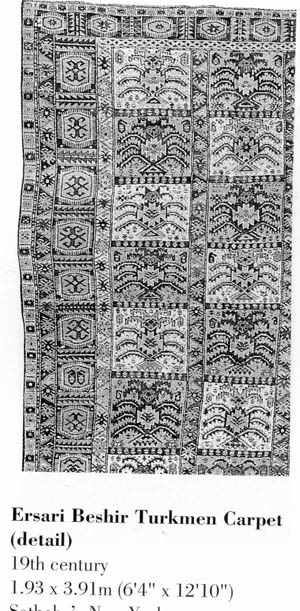
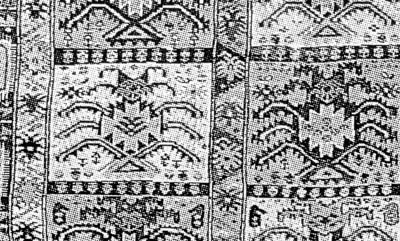
I think the floral or
vegetal hypothesis is more serious than the animal hypothesis.
For
example we can look at the Yomud tent band "creature". In the same Hali issue I
have found an enlarged picture of the "bug". It is possible to see the floral
nature of the central part of the motif. The two symmetrical devices on each
side of the central stalk can be read as "fantastic creatures" or dragons
warding the central flower, or more simply vegetal protuberences rendered in
"animal style drawing".
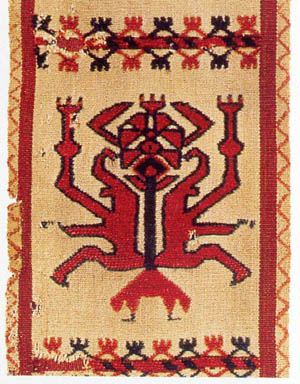
We can see similar stylistic hybridation in some details of my
dragon sumak
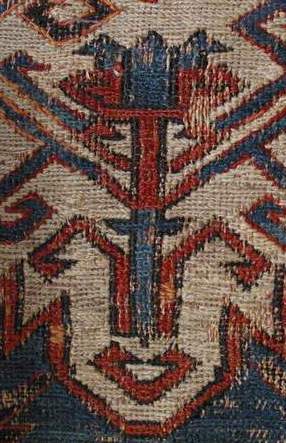
Often the "vegetal/floral" or "animal" reading of the motif
depends of the direction of the reading. If you put the Yomut device upside down
it apears to be more animal than floral.
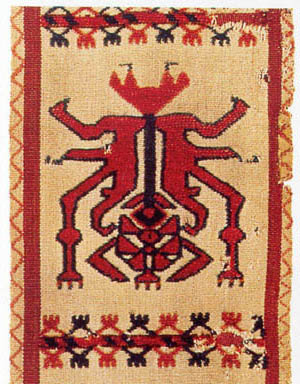
I think it is a conscious
game that weavers play.
The origin of the "tarantula" design can be the
classical motif "flower in a vase", or "flowering shrub", as we can see in the
schemas of Peter Stone's book, in the Bakhtiari pages


It can be also a derived
form of the "tree of life" as we can see in very stylized forms in Anatolian
weavings (Erbek's book, pages tree of life), motifs from Milas and Midge
areas
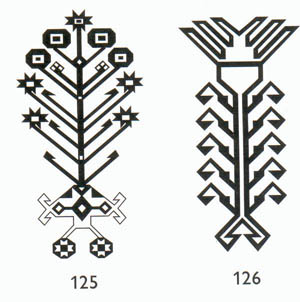
The explicit animal motifs exist in weaving vocabulary, but
with less numerous forms (birds, scorpions, quadrupeds, dragons, lions). And
they are generally not symmetrical.
The scorpion is present in Anatolian
weavings, with schematised forms that are generally far from the "tarantula".
Some scorpions are non symmetrical, some are symmetrical with generally two axes
of symmetry. The only example I know that is quite near of "tarantula" with only
one axis of symmetry, is the picture 54 in the following image (from the Erbek's
book, page scorpions).
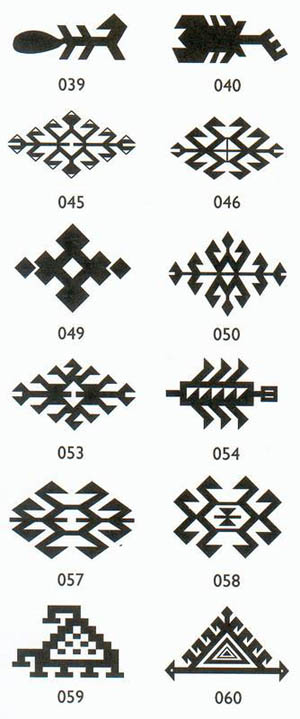
I think the animal look that floral motifs take when woven by
"tribal" weavers is due to the systematic use of the axial symmetry. Symmetrised
lateral protuberences, even floral, refer immediately to animal forms as they
are read like legs. This fact is amplified when the motif is not symmetric in
the other axis: the shape has a tail and a head (see the Yomud device). This
immediate reading is surely related with a very old part of our brain, as in the
deep past of man little animals with numerous legs were in the same time enemies
(louses, spiders, crab-louses..) or food (ants, bees, crabs and so on) and then
very important for the life of men.
Voilà
Amicales
salutations
Louis Dubreuil
Posted by Steve Price on 12-02-2004 05:32 PM:
Hi Louis
I agree. When representational motifs in central and western
Asian weavings are unambiguous, they are usually floral or, at least, vegetal.
On one point, though, I disagree.
You wrote, Symmetrised
lateral protuberences, even floral, refer immediately to animal forms as they
are read like legs. ... surely related with a very old part of our brain, as in
the deep past of man little animals with numerous legs were in the same time
enemies (louses, spiders, crab-louses..) or food (ants, bees, crabs and so on)
...
Our brain does a lot of "filling in" of images that are presented
visually, not only making insects out of things with symmetric protuberances.
Here are a few simple examples to show how little it takes to make your brain
see a face and attach a meaning to it:



Regards
Steve
Price
Posted by Louis Dubreuil on 12-03-2004 04:58 AM:
Brain
Hello Steve
There is no disagreement between us indeed 
 . The example you show is the best
example of the power of the brain to read vital signs in highly abstract forms.
Why are we able to read human sentiments in few lines
. The example you show is the best
example of the power of the brain to read vital signs in highly abstract forms.
Why are we able to read human sentiments in few lines  ? this is because it is absolutly
vital to read the faster as possible the intentions on the face of the
individual you have in front of you
? this is because it is absolutly
vital to read the faster as possible the intentions on the face of the
individual you have in front of you  . The corporeal communication is priority holder over the oral
communication. This is true even with primitive animals and overspread in all
mamalian creatures.
. The corporeal communication is priority holder over the oral
communication. This is true even with primitive animals and overspread in all
mamalian creatures.
Amicales salutations
Louis
Posted by Tim Adam on 12-03-2004 06:37 AM:
Hi Louis and Steve,
I wish I'd understand what you two are talking
about, but I think it is an interesting hypothesis that floral forms tend to be
symmetrical while animal forms tend to be asymmetrical. I am sure one can easily
find counter examples, but maybe not that many.
Regards,
Tim
Posted by David R.E. Hunt on 12-03-2004 07:51 AM:
Perception=Cognition
Louis,Tim, All
Just a few quick observations folks.
Perception
is a cognitive process, thus learned, as such our interpretation of design
symbols may well differ from those of Turkmen.
If we take a close look
at these Beshier Tarantulas, we will notice that the segmentation of the body
does not reflect that of an arachnid, nor the number of appendages. I have seen
similar motifs on tentbands, if I'm not mistaken, which do resemble wheat. These
same said, or similar, motifs can also be found on Balouch carpets.
While
I share a belief in a vegetal origin of many designs, I think taking this a step
further, and considering the symmetry of the weaving medium itself, with it's
horizontil wefts and verticle warps, moves us closer to an understanding of the
origin of design motifs.
In his Arts and Crafts of Turkestan, Kalter
describes the symbiotic relationship which existed and exists between settled
and nomadic people, and describes the evolution of nomadic culture as being a
reaction to and proceeding from urban culture.
As for symmetry I think we
gotta be careful. I know of an asymmetrical design or two which are clearly
vestigal floral
patterms yet often refered to as scorpions, and while there
are exceptions to every rule, I would exercise some caution.
Dave
Posted by Marvin Amstey on 12-03-2004 10:39 AM:
This discussion seems to be going to the way of another one done here a few
years ago wherein everyone was seeing birds' heads and eagles. Certainly the
examples presented above by Louis from Erbeks's book illustrate the "bird's head
motif we talked about before. Another excercise in futility. Wendel's response
says it all. Have a great weekend.
Posted by Michael_Wendorf on 12-03-2004 06:26 PM:
Do Beetle bags still Bug Wendel
Wendel:
Given your seasonal response above, I have a question ... Do
Beetle bags still bug you?
Can't agree with Marvin's crabby response -
not an exercise in futility, just an exercise.
Carry on, Michael
Posted by Louis Dubreuil on 12-03-2004 07:10 PM:
Hello Marvin
Nobody has yet talk about bird's heads  . The examples draught from the
Erbek's book refer only to flower/vegetal designs (tree of life) and to those
the author has identified as being "scorpions". It is certainly possible to
contest the work of this author, but it seems to me that it is a work mostly
made from field studies or turkish rug culture and from the weavers' names of
motifs.
. The examples draught from the
Erbek's book refer only to flower/vegetal designs (tree of life) and to those
the author has identified as being "scorpions". It is certainly possible to
contest the work of this author, but it seems to me that it is a work mostly
made from field studies or turkish rug culture and from the weavers' names of
motifs.
We all know that there is always a gap between the actual name of a
motif and its original signification. But this work has the merit to exist and
to give us a "complete" survey of the anatolian matter. But also we have to be a
bit distrustful about "complete and definitive" works !
About the
animal drawings on rugs, they are often non symetrical when they have a bit of
realistic rendering : animals are drawn side face, and there is no symetric
animal viewed side face. The only symetric representation side face of animals
is the one of "fantastic " animals like two headed quadrupeds we can see in the
Opie's book on Luri-Bakhtiari weavings.
Animals are drawn in the symetric
manner when seen from above. But this is never the case for realistic birds or
mammalians.
For the scorpions we have two kind of drawings. The non
symetrical is the schematic scorpion viewed side face (a triangle with a tail
fig.59, 60). The symetrical is the beast viewed from above, but in this case
this is generaly a symbolic or an abstract shape (fig 45 to 58) named "scorpion"
by the weaver. Figures 39 and 40 are realistic and symetrical for the body but
not for the tail. This fact is due to the system of drawing on the surface of
the rug : all shapes are flat projected without perspective or 3d taking care .
The body is directly projected on the plane and the tail is projected after a
90° rotation : the scorpion is viewed from above and side face on the same time

Flowers are
generaly symetrical on rugs : one axis (tulips, shrubs or bunches of flowers
viewed side face or from face) or two axis (flowers viewed from above as
rosettes like in the Mina khani design). The only "vegetal / abstract "motif non
symetrical is the boteh.
The other non symetrical drawing of flower motifs
are realistic renderings as "french roses" or more intricated "gul farang" or
non abstract rugs' motifs as in realistic garden carpets.
Amicales
salutations
Louis
Posted by Jerry Silverman on 12-03-2004 08:20 PM:
With birds it depends on the perspective. Here's a Caucasian piece with birds
- in profile and face-forward. Asymmetrical in profile: symmetrical
face-forward.
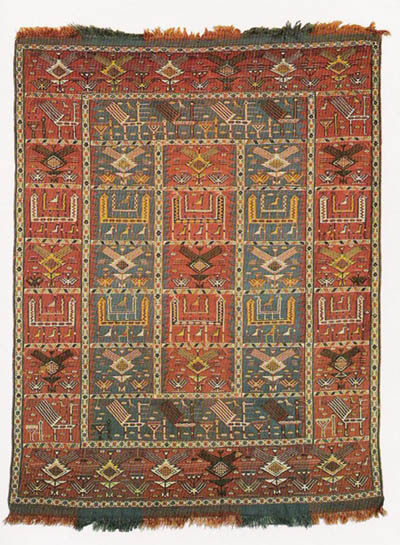

...much as one would
expect.
Cordially,
-Jerry-
Posted by Louis Dubreuil on 12-04-2004 06:14 AM:
Bonjour Jerry
You are right, "realistic" birds can be symetric when
viewed face forward or even from below, flying. But it remains a relativly rare
disposition. Realistic birds are currently side face drawn and the symetry can
be retored by puting two assymetric birds, face to face, symetricaly on either
side of an axis. We can find again the symetry in "abstract" birds, but this is
not the general rule as even in abstract drawings birds remain assymetric.
I
have forgotten in my review of symetric animals in rugs the tiger rugs of Tibet
which show animal pelts viewed from above with a certain "natural" symetry and a
special kind of old anatolian "animal pelt rugs" that are drawn with the same
principle.
Louis Dubreuil
Posted by David R.E. Hunt on 12-04-2004 10:50 AM:
Birds in the Trees...
Louis and All
I hear what you are saying, but I think you need to take
a closer look at the so designated frontal view of a bird as posted by
Jerry
Silverman. I've seen few birds in which it's wings are attached to a
head which is in turn larger than its body. This looks more a variant of a
floral form such as below.
Dave
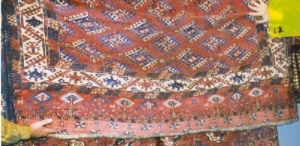
Posted by Tim Adam on 12-04-2004 11:17 AM:
David,
I think the wings are attached to the bird's body (in the
frontal view). The head is above the body, and quite
small.
Regards,
Tim
Posted by David R.E. Hunt on 12-04-2004 01:14 PM:
Perspective?
Tim
I don't agree. They , these two figures, seem to me of
differing
structure. I understand the similarities, but the requisit
interpretive gymnastics strike me as proof positive of differing
intent.
Dave
Posted by Jerry Silverman on 12-04-2004 03:04 PM:
Nah. Little head. Big body. Long neck that lifts the little head far above
the body (which can be seen in profile). If the picture I scanned were bigger
I'd have cropped out a single face-forward bird, and this would be more easily
seen.
Turkmen weavers knew what a chicken looked
like.
Cordially,
-Jerry-
Posted by David R.E. Hunt on 12-04-2004 11:22 PM:
A compromise
Tim, Jerry All
I'll admit that this figure could be a full frontal
representation of a fowl, albeit a stylized example of this floral trident with
some zoomorphic attributes.
Aside from the resemblence to this floral
design motif, my primary objection to the interpretation of the motive as a fowl
proceeds from the discrepency between the structure and proportions of the
constituent elements, in comparison to the lateral view of what is obviously a
bird.
Compare the points of attachement of the wings, the proportional
equivalence of the the length of the necks and the orientation of the tails to
the bodies.
If these two design elements we concieved and constructed as
like components, the proportions and details would be more complimentary ,more
similar.
The two elements are floral and fowl, but so stylized as to seem
near the same.
Also, I grew up in the country, my next door neighbor was
a dairy farmer, and we both kept chickens, so I know what chickens look like,
rest assured. There is a resemblence, but it's a stretch.
Dave
Posted by Louis Dubreuil on 12-05-2004 10:48 AM:
Bonjour dave and all fowl lovers
The fowl is roosting on the top of
the flower, I repeat, the fowl is roosting on the top of the
flower.
Meilleures salutations
Louis
Posted by David R.E. Hunt on 12-06-2004 08:56 PM:
Comparison/Contrast
Louis and All
Find below a detail of from a verneh in Thompson's
"Oriental Carpets", pg. 98. No birds here, but the same design and same type of
weaving.
Dave

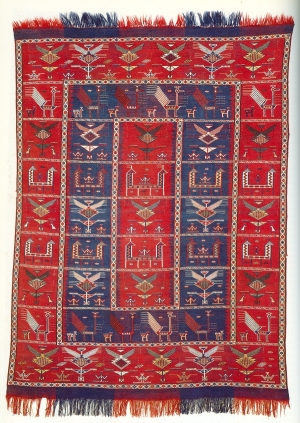
Posted by Wendel Swan on 12-07-2004 10:32 AM:
Hello Jerry and all,
I was initially skeptical that we were seeing
front and side views of a bird (it is a peacock), mainly because it was a
convention that I had never before read about or observed.
Similar
devices can be found on other covers from the Caucasus, including this one
formerly in the Dave Chapman collection and pictured in FTBTS.
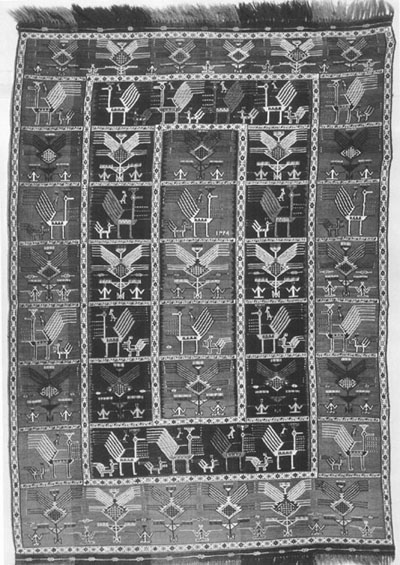
I placed two of
the panels side by side without changing scale.
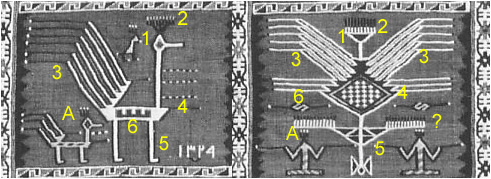
Comparing the frontal
and side views, one finds nearly exact correspondence between the following body
parts of the larger peacock:
1. Head.
2. Comb
3. Tail
4.
Body
5. Legs
6. Wings
There is no obvious explanation for the four
lines above the number 4, but the color and spacing are obviously
representations of the same parts (one dark, three light lines).
In
addition, there is a correspondence of the combs on the smaller peacock (at
A).
There is also another element that remains in question, the lateral
devices on the frontal view shown at the ?. We could speculate that they may
have something to do with the tail(s) of one or two smaller peacocks.
The
frontal views do look remarkably like floral forms, but I?m now convinced that
frontal and side views of the peacock was intended, although it is not unknown
for there to be an expression of duality in some designs.
Perhaps we'll
now notice this same phenomenon in other weavings.
Wendel
Posted by Stephen Louw on 12-08-2004 05:59 PM:
Dear Filiberto
Thanks for the earlier reference to the example in the
Wiedersperg Collection. You noted that you thought the size given in the Ghereh
article (2.36m x 1.27m) was incorrect.
In the catalogue of the
collection edited by Pinner and Eiland, the size is given as 3.61m x 2.01 cm
(142" x 79"), with a knot count of 7(h)x9(v) or 63 per sq. in. (Mine is roughly
8(h) x 11(v).)
There is an almost identical example of this version of
the "compartmental tarantula" design in the Wher collection. This is also
squarer in format, with the much rarer two-legged
spider/scorpion/Martian/flower/germ of wheat; as opposed to the three-stemmed
version in my and the Jourdan examples.
The size of this example is
3.72cm x 2.9cm. It is dated to ca.1800, although I can think of no basis for
that date.
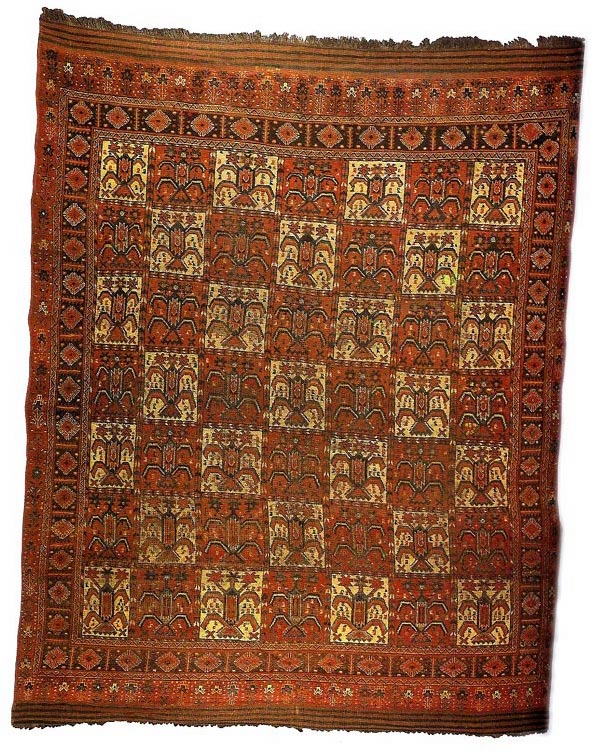
Significantly, this carpet was published as part of an article
in honour of the late Lesley Pinner. We have all recently been saddened by the
loss of Robert Pinner.
__________________
Stephen
Louw
Posted by Filiberto Boncompagni on 12-09-2004 05:10 AM:
Hi Stephen,
Compare the two images… Colors apart (different
typographic rendition) that is the same rug! The slight difference in size can
be easily explained with the irregularity of the rug.
Either there was a
mistake in GHEREH or the rug changed collection.
Regards,
Filberto
Posted by Fred_Mushkat on 12-09-2004 10:34 AM:
Hello all,
For the sake of completeness, here is a photo of a Fars
area band with a fowl roosting on a flower.
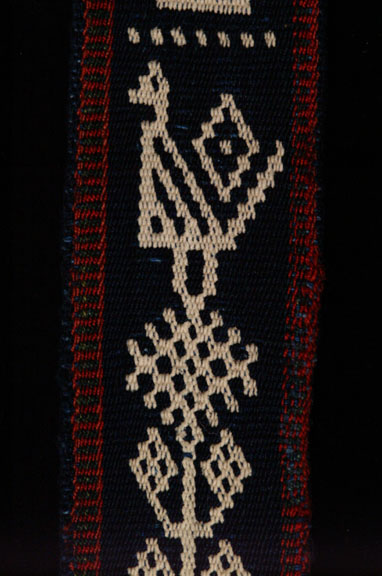
Regards,
Fred
Mushkat
Posted by David R.E. Hunt on 12-14-2004 11:25 PM:
Still another Version
All
Another version of this verneh with the floral/fowl motif, from
here on the Turkotek archive.
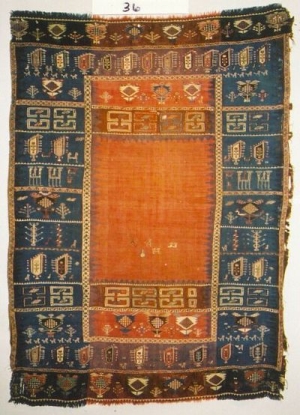
Guiling, isn't
it.
Dave
Posted by Horst Nitz on 12-16-2004 12:26 AM:
Hallo All
Picture 1 shows what can be taken as an animal
form.
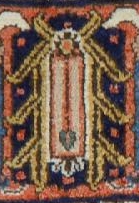
Picture 2 shows what else it can be or what it is if one
changes the context.
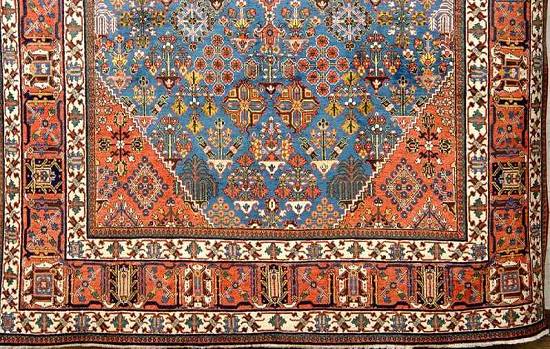
The vexatious nature of this and many other drawings – let
alone technical aspects for the time being – appears to reflect the tension
field between Islamic picture prohibition and what could be called icons or
images owed to traditional themes and believes, superstitions amongst them. This
may not be the very best example as pictures are taken from an early 20th
century workshop carpet (Meimeh) but it may convey the idea. Context is
all-important when it comes to interpretation and may draw from sources in
anthropology, regional history, Islam, history of arts etc. I can see no short
cut.
Regards,
Horst
Posted by David R.E. Hunt on 12-16-2004 08:48 PM:
Bukhara and Middle Amu Daria
Stephen and All
Find below a color representation of Kush Beggi,
Interior Minister of Bukhara as depicted in Thompson's "Turkmen" on pg. 183,
seated upon one of these palace size Bukhara or Beshir rugs.
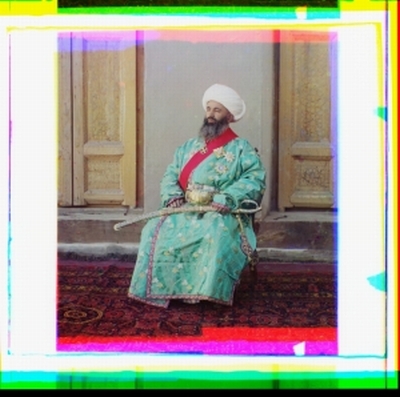
There is a
downloadable Tiff scan of this photo which reveals incredible detail on the
Library of Congress website search page. Just type Kush beggi into the search
engine here
For balance, let's throw in a photo of the Emir as well.
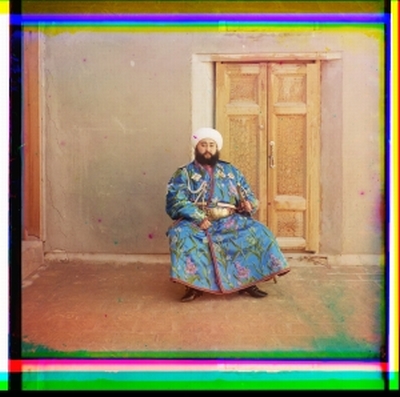
In his
introduction to carpets of Bukhara, Thompson, in the chapter of the same name
states that
"For a long time, carpets made in the former Emirate of
Bukhara, which includes the middle reaches of the Amu Daria River Valley, have
been attributed to the Ersari, the largest Turkoman tribe in the area. But the
Ersari produced only a part of the output of the region."
Much is made
of the relationships between these more cosmopolitan weavings and designs found
in jewelry and other decorative arts, such as those demonstrated by this apex of
the scabbard sported by Kush Beggi as above,
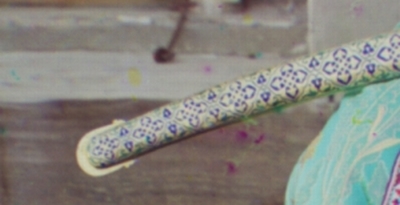
and this Beshir
carpet.
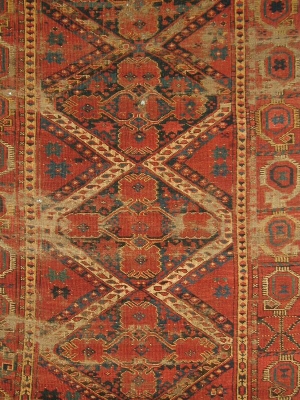
In "Turkoman", Jourdan states, in a describing plate 233 on pg. 260
that
"Robert Pinner, discussing a rare carpet in the Museum of Islamic
art, Berlin, noted that there was a rare group of Saryk examples with either the
gulli gul or temirjen gul used as a main motif, but that these were found more
often on Ersari carpets. Considering both the ethnographic relationships of
these two tribes and their common use of such motifs, Pinner concluded that such
guls were used on carpets from the middle Amu-Darya region and were used there
both by the Ersari and the Saryk during the early 19th century before the latter
migrated westward to Merv. Compared to other symmetrically knotted carpets with
this gul, the presenst (Ersari) example differs only in the motif at the center
of each gul and in the use of the minor gul seen here.".
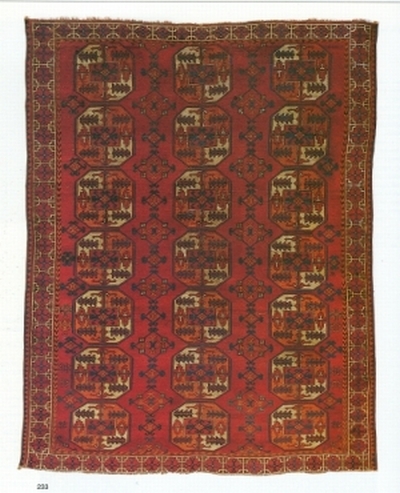
Could commercial
forces have exerted their influences upon Turkmen carpet designs even at these
early dates, in trade centers as Bukhara, resulting in such hybrids as this
Ersari carpet with Tekke guls and Yomud borders, plate 239 of Jourdan's
"Turkoman" and described as
"Although looking very much like Tekke work,
the octagonal form of the Tekke main guls would not normally be found on a Tekke
carpet of this age. The design in the white ground main border is interesting
and no close analogies can be found on any of the Tekke main carpets."
?
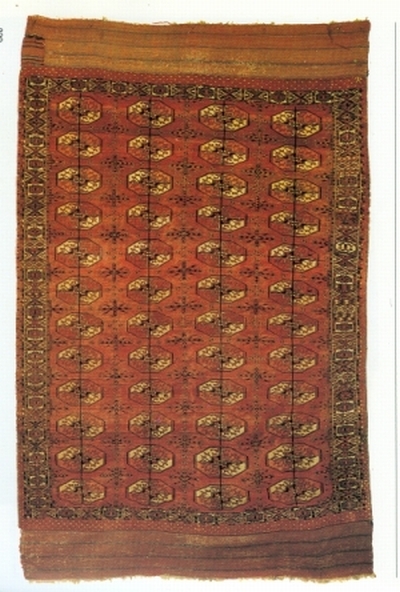
Also, could same said forces account for other hybrids, such as
this Ersari/ Balouch prayer rug, possibly modeled after those Beshir/Bokhara
prayer rugs which were made in such numbers?

And last,
this compartmentalized Beshir from the Turkotek archive, which is likely based
upon the same model as your so called "Tarantula Beshir" and described by Pinner
in "Between Black Desert and Red" as likely proceeding from Bakhtiari
rugs.
Dave
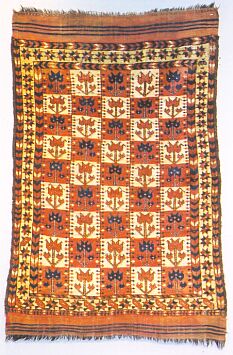
Posted by Horst Nitz on 12-20-2004 06:21 PM:
Hallo David
You are rising very interesting questions. Unfortunately,
I have neither expert knowledge nor time to enter a in-depth discussion now. I
would like to pass two observation however. First, the motive between the
cruciforms on the Emir's sheath reminds me very much of motives that have
travelled as far west as the Balkans and occurs frequently on Shasevan weavings,
a göl-like hooked medaillon form between rams horns; second, to my knowledge the
Temirdjin göl is shared between the Ersari and the Saryk, but white quadrants
with very few exceptions appear to be distinct characteristics of Saryk
work.
Regards,
Horst
Posted by Horst Nitz on 12-20-2004 06:33 PM:
Hi David,
again and referring to the last image that has just build
up. Are you suggesting, the motive has travelled east to west from Bakthiari
pastures in western Iran? I do remember Siawosch Azadi having suggested that the
Baluri (Baluch) may be related to the Bakthiari, both using or having used the
symmetrical knot. I am not sure whether this is a widely accepted
view.
Regrads,
Horst
Posted by Horst Nitz on 12-20-2004 06:36 PM:
Oh blast,
... has travelled west to east from Bakthiari pastures of
course ... I think I better shut up for the time
being.
Best,
Horst
Posted by David R.E. Hunt on 12-21-2004 07:16 AM:
Two From Thompson
Horst and All
Find below two high end Salor trappings from Thompson's
Oriental carpets. Notice the similarity between the minor guls of both pieces to
the minor gul of the Temirjen gul Ersari above.

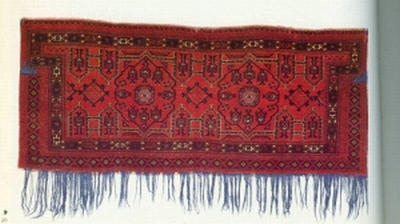
As for the Bakhtiari
connection, it appears that the people of the Amu Darya were familiar with their
products and made use of the panel format.
As for the Temirjen gul, it
seems that it's use in Saryk weaving is extremely rare, and most all temirjen
carpets are Ersari. White quadrants are more indicative of an earlier period of
Ersari weaving when lighter colors in general were used, as opposed to
indicating a Saryk origin, IMHO.
I still don't think your Ersari is a
Saryk
Dave
P.S. Find here detailed images of the
Ersari
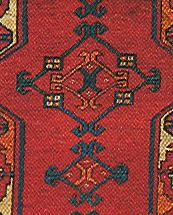
and both Salor minor guls.
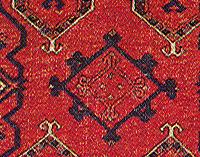
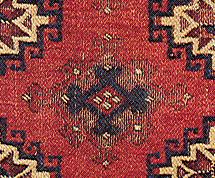
Posted by David R.E. Hunt on 12-25-2004 09:01 PM:
Comparison and Analog
Horst and All
Is it possible that this Beshir prayer rug, which was
made in such large numbers, and seems to have inspired a sea of imitators, is
the Sine quo non of Turkmen and Balouch prayer carpet designs in the Tree of
life format?
In "Between Black Desert and Red", Robert Pinner states
that
"Whatever the actual kinship among these (Ersari) groups, their
lives are similar, particularly as almost all live within the Amu Darya basin or
nearby waterways that drain mountains to the west", and "There are still tent
dwellers among the Ersari group,
but most are sedentary, and the trappings of
nomadic life may consequently form a relatively smaller part of the total woven
woven output". He continues with
"Carpets of the Ersari group are
substantially more variable in size, with some pieces- apparently among the
oldest surviving Tuirkmen rugs- far larger than the Tekke main carpet and
clearly made for an urban enviornment".
"As the areas where these were
woven lay mostly within the Emirate of Bukhara, ande some in the Emirates of
Kokand and Khiva, it is likely that the weavers enjoyed the patronage of
town-dwellers for at least several centuries and to a greater extent than did
the Tekke, Salor, and Saryk. Even now the remnants of the early, traded rugs
that we know as Beshir may be found occasionally in Bukhara, and with the
arrival of the Trans Caspian Railway, a lively trade in these pieces
developed."
Might this sedentary lifestyle account for the large sizes
attained by these Ersari Chuvals, such as the one below?
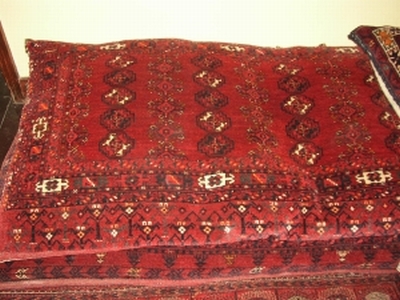
I have found some
paralles between the drawing of some design elements demonstrated by this
chuval, and an interesting Balouch group prayer rug from the Weidersperg
collection as depicted in "Between black Desert, Etc.".

Pinner notes,
"The
prayer rug is of no specifically identifiable group, although it is considered a
Baluchi type. It is interesting in that it shows three mihrab-like elements
across the top that are strongly suggestive of those found on many Beshir-type
prayer rugs."
Compare the border pattern on the left of this Ersari
chuval
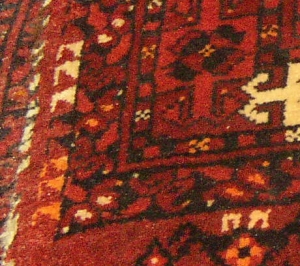
to these filler devices found within the Kochak depicted
below
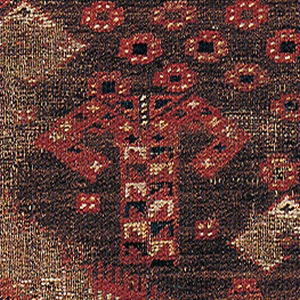
Also, compare these chemche- like elements from the Ersari
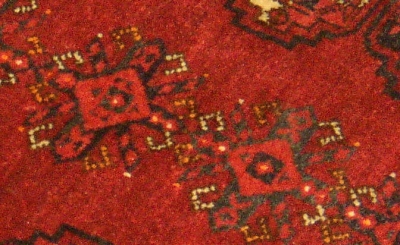
and
Balouch respectively.
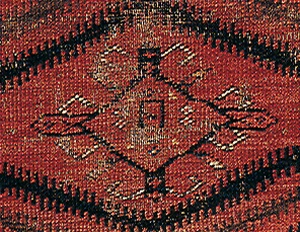
Consider the
following Beshir Ersari prayer rug as depicted on pg. 298 in Uwe Jourdan's
"Turkoman" and accompanied by the following caption
"Robert Pinner wrote
that this piece might almost be taken for"it's famous relative from the Dudin
Collection in Leningrad which has been dated by Tzareva to "not later than
the beginning of the 19th century."
Jourdan concludes by stating that
"Because of it's rarity, it's value is almost impossible to estimate".
It
should be noted that the Dudin piece was purchased 1901 in Bukhara and described
at the time as Kizil Ayak.
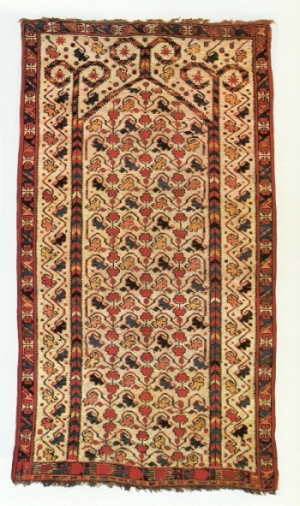
Another
incarnation from Jourdan's" Turkoman".
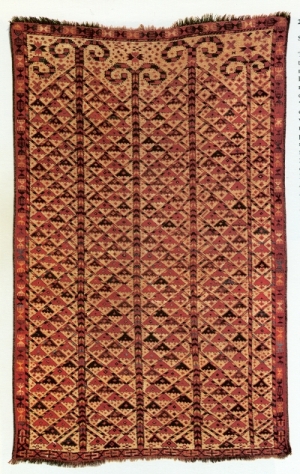
In these
Beshir versions we find the disarticulated artifact of a Herati design converted
into a flower, undergoing the metamorphosis into a floral motive which will find
expression in unnumbered Balouch prayer rugs?
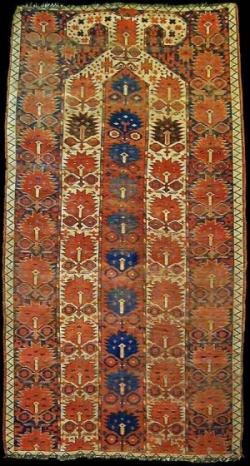
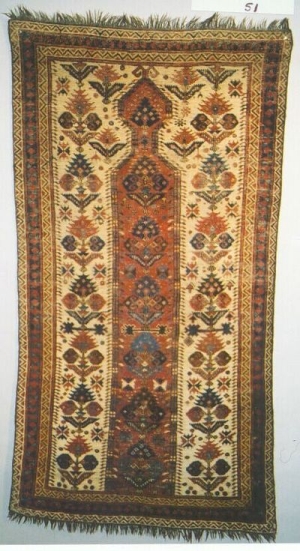
Some examples as of
above.
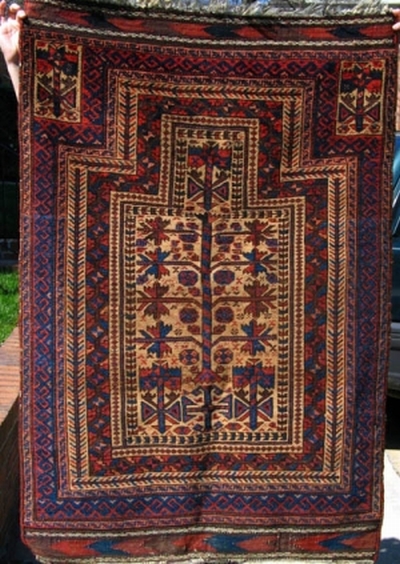
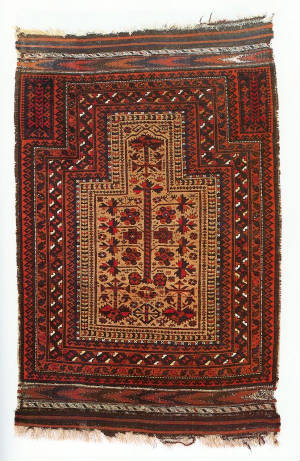
Dave 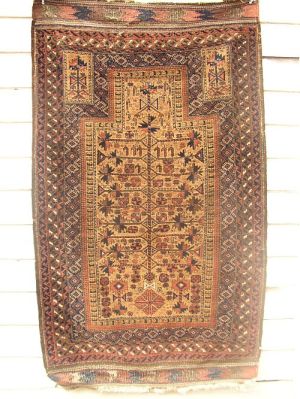
In the above mentioned link to the Dudin Collection,
Moshkova notes that
"The typical artistic particularity of the Beshir
rug is the absence of a common color for both ground and pattern in contrast to
all turkomen rugs."
Is it possible that the origin of the camel ground,
so often seen in the Balouch prayer rugs,is an imitation of this Beshir
aesthetic?
Or could this lighter ground be reflective of an earlier period,
when the white ground was associated with marriage and yurt culture?
Why so
many white ground Kapunuk?
Posted by Horst Nitz on 12-27-2004 05:58 PM:
Hi David
Sorry, to let you down. Your questions are very specific and
half way through with them I start thinking I am not on save grounds on the
subject.
Thanks for enquiring about my Ersari-Saryk. It serves me well
and I am having fun with it. It is top layer in my sitting-room and cushions my
back when the children demonstrate on me what they have learned at their Judo
class.
Best wishes,
Horst
Posted by Jerry Silverman on 12-29-2004 04:49 AM:
All right, David, I just noticed.
Where did you find that picture of
me (see "Emir" above) in my Halloween costume?
Granted, I've lost quite
a bit of weight since that picture was taken - but I won first prize at the
costume contest at Butch McGuire's: $100 and the acclaim of the
multitudes.
-Jerry-
Posted by David R.E. Hunt on 12-29-2004 07:36 PM:
To protect the guilty...
Jerry
Any resemblance to anyone, real or fictitious, is entirely
coincidental. And I refuse to reveal my sources
Dave
Posted by David R.E. Hunt on 12-31-2004 04:52 PM:
Beshir = besh shahr or "five villages"?
Stephen and All
Find below a map of Turkmenistan and surrounding areas
from the end papers of Johannes Kalter's "The Arts and Crafts of
Turkestan".
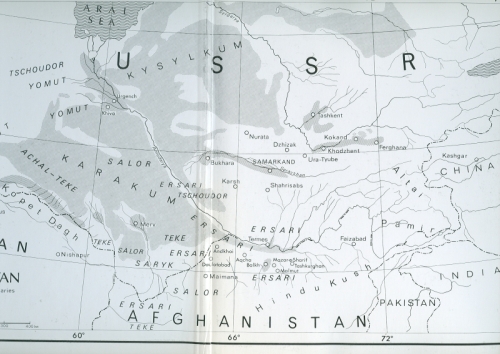
Notice the proximity of the middle Amudarya to both Merv
and Bokhara. Looks to be the heart of Turkmen territory.
Find
below an Ersari Prayer rug from the Eiland's"Oriental Carpets"
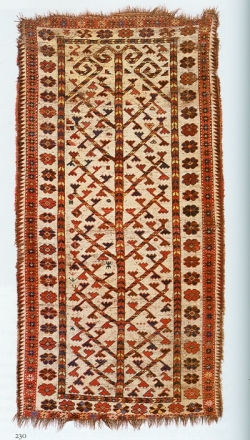
followed
by a Beshir prayer rug, dated to 1893, from Khalter's'Arts and
Crafts,Etc.".
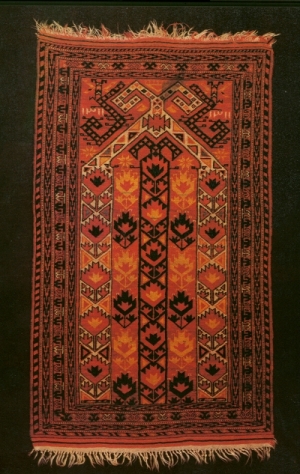
Given the choice, I would have supposed designation the
other way around, Eiland's Ersari to be a Beshir and the Beshir more to the
point as to what I expect in an Ersari weaving.
In "Oriental
Carpets", the Eiland's state
"Rugs with the Beshir or Beshiri label
are among the puzzles, as a number of sources indicate that these pieces are
named for a town (besh and shahr, or "five villages") on the Amu Darya. With
several neighboring towns, this as alleged to have been a nineteenth
century-century production center for a type of rug often inspired by Persian
designs and woven mainly for external markets. Although the authors have not
visited Beshir they have confirmed that rugs of this general type are still
woven in Uzbekistan and are attributed by Uzbeki dealers to the vacinity of
Beshir."
Find below a plate from Khalter's "Arts and Crafts of
Turkestan" depicting both an Uzbek (top) and an Ersari Chuval.
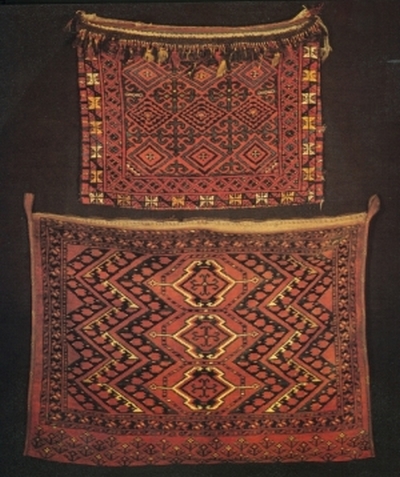
Interesting
that this "bow tie" device in the border of the Uzbek bag is the same at that
found in this Early Beshir from a previous post,
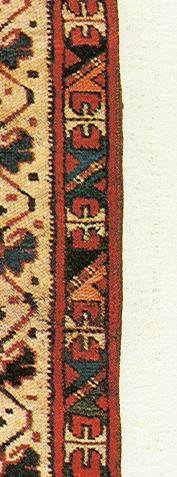
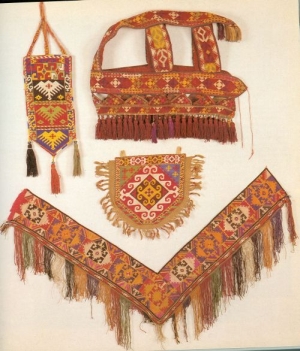
and also in
the main border of this chevron shaped Uzbek "Saye Gosha" trapping. Follow this
Link
to a previous Turkotek discussion of Turkestan material culture.
Here
is what Kalter has to say about the Uzbeks
"The ancestors of the
Uzbeks, like those of the Turkmen, invaded turkestan as armed nomads. The name
of this people, speaking an east Turkic dialect, possibly goes back to one of
the leaders of the Golden Horde of the Mongols, Uzbek Khan (1312-13 -1340). The
prorocess of the formation of the Uzbek people was extremely complex, again like
that of the Turkmen. It was brought about in the 15 th century when Turkic,
Mongol and old-established Iranian groups fused during the decay of the Golden
Horde. In the 16th century, part of the Uzbeks conquered the most important
Turkestan towns and established themselves there, forming the leading class with
considerable contingents of urban merchants and- to a lesser extent-
artisans.Others setteled down as farmers in the the villages of the oasis. In
Russian Turkestan, the Uzbeks had abandoned the nomadic way of life almost
completely by the 19th century, but small nomad Uzbek groups did exist in North
Afghanistan untill very recently."
Of the Tadzhiks, Khalter
states
"In the early middle ages, the word "tazi" was the Iranian term
for Arabs, that is to say Muslims. It was then used by the Turkic uinvaders who
had not yet been converted to Islam to denote those -mainly Iranian- groups
living in Turkestan who had been islamized at a very early period. Today the
name "Tadzhik" is a collective term which includes all those population groups
in Turkestan and Afghanistan that speak a West Iranian dialect closely related
to modern Persian."
and then collectively,
"Since the 16th
century, the urban civilizations of Turkestan have been supported chiefly by the
Uzbeks and Tadzhiks together. The civilization of the cities emerged from a
combination of Iranian and Turkic cultural elements which were molded according
to Islamic conceptions; as has already been mentioned, decisive impulses were
given during the Timurid period. Ideas were also recieved from Persians,
Afghans, Indians, Chinese and others who were living in Turkestan towns as
merchants, and by means of the trade effected with their countries of origin
which at times was very busy."
Posted by David R.E. Hunt on 01-05-2005 07:15 AM:
More Bow Ties
Stephen and All
I found another bow tie element in this border as seen
below in the close up image,
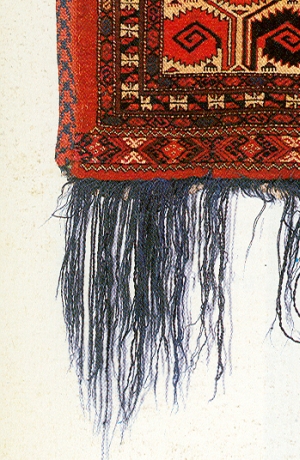
As taken from this
Salor Trapping from Thompson's "Oriental Carpets".
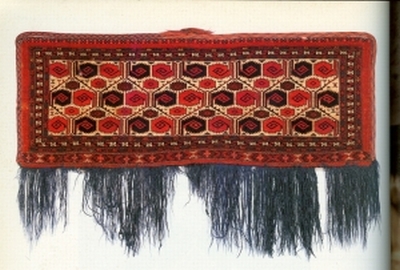
Is the Salor motive an
imitation of the Uzbek motive, is the relationship of the reverse,or could they
both represent a common design motive found in other media, such as in the
embroidered Saye Gosha trapping above?
Find below a pair of earrings
from plate 117 of Kalter's "Arts and Crafts of Turkestan".
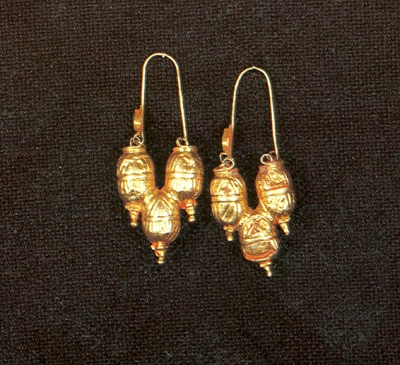
Of this
artifact Kalter states
"Earrings composed of three spheroids, like ours
from the Ferghana valley, have been shown to go back to the jewlery of ancient
South Arabia and pre-islamic Iran and had spread throught the islamic world even
in the age of the first caliphs".
Could these be the proverbial
pomegranat?
For further ramblings on the subject of design migration,
follow this Link to a previous salon discussion on
Turkotek.
Dave
Posted by David R.E. Hunt on 01-05-2005 05:35 PM:
From Saudi to Amu darya?
Find below the image of a Saudi Arabian Bedouin weaving sporting the bow tie
device as seen on the Uzbek, Salor, Ersari, etc. weavings as above, in the event
you haven't read far enough down my excruciating salon, as found at the link
above, to have seen it. 
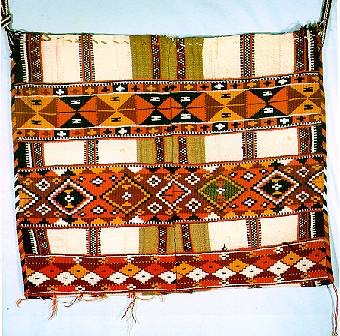
Dave
Posted by David R.E. Hunt on 01-06-2005 09:07 PM:
Comparison and Analog II
All
Find below an Uzbek kelim bag with face in soumak
technique.
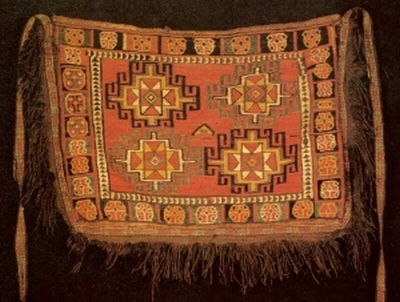
Notice the scale of the rosettes in the border, the dark
fringes reminescent of salor fringe, and this pale green color which seems to
appear often in both Turkmen and Balouch rugs, and also seems to represent some
technique or style of decor in which the single pale color, in contrast to the
balance, is found among more saturated tones.
In the Salor bagface
fragment from "Pacific Collections" found below we see the corresponding Memling
gul and a similar use of color albeit red instead of green.
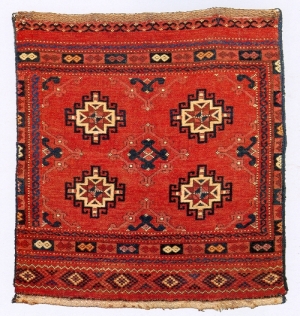
Also, this
Thompson piece from above.

In what artistic heritage do
we see the earliest appearence of this Memling gul?
Find below
another example of this above mentioned contrasting technique, this time of the
Ersari. And green too.

Could this
variation in the field, almost as abrash but seeming intentional, be a further
example of this style?
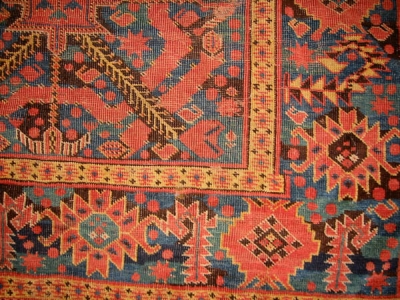
Dave
Posted by David R.E. Hunt on 01-10-2005 07:47 AM:
Comparison and Analog III
Stephen and All
Find below a wool embroidered kelim of the lakai Uzbek
from Kalter, 150x342 cm..
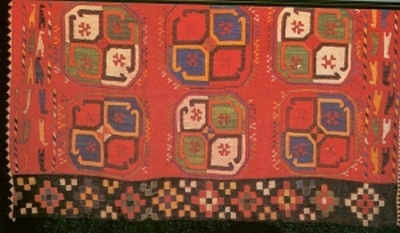
Notice how the
drawing of this end border parallels the Chamtos border at the bottom of this
"Pacific Collections" Salor fragment(as also demonstrated by two of the three
other Salor trappings found in this thread),

as do the "S"
border and memling gul like decor of the following Lakai Uzbek embroidered tent
bag from Kalter, 52x118 cm..
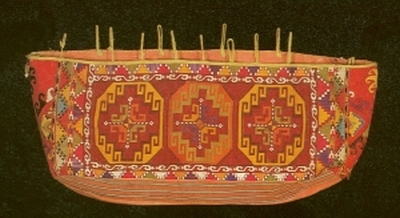
If I am not mistaken,
this next band, the stepped triangle adjacent to the "S" border, is also found
in much Turkish weaving.
Kalter states
"Culturally- with
regard to the development of architecture,poetry, the arts of the book and
painting, and also the so-called decorative arts- the importance of the timurid
period cannot be overestimated. Forms and ornaments which appeared in their
characteristic shape for the first time in the Timurid period have dominated the
traditions of arts and crafts untill well into our century."
Dave
Posted by David R.E. Hunt on 01-10-2005 08:11 AM:
Into the Mix
Stephen and All
Interesting, this tent or bedding bag of the last post
reminds more of more western traditions than Turkmen. Some other groups have
exerted their influence upon Turkestan, as Kalter states
"If today
the Arabs are only to be found in one of the smaller settelments on the Amu
Darya as compact groups, it may nevertheless be assumed that they,too,exerted a
certain influence on Turkestan's material culture. This also appliesto the great
nomad peoples of the Kazakhs and Kirghiz who must however be excluded from this
publication since their possessions are not represented in our
collections."
Notice the white ground of the following Kirghiz
weaving, and it's simularity to the Kazak.
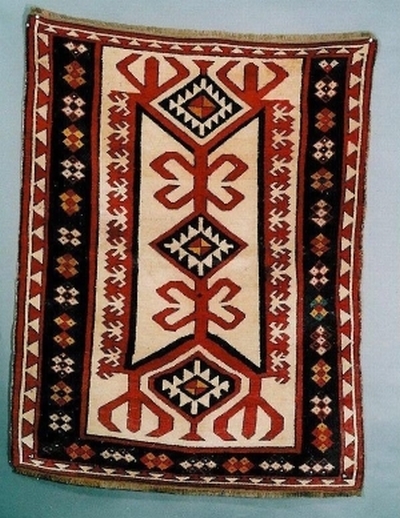
This Kirghiz
piece (below) seems of the Ikat design variety, and notice the "dice" flower
border seen so often in Turkmen weaving. Are those lappets at either end? On
Gerard Paquin's OttomanTextile Designs in Turkish Rugs we read
The
choice of lappets as a type of end border in defining the form of Ottoman silk
yastiks and their wool descendants evolves naturally from the artistic heritage
embraced by the Ottomans. Timurid and Jalayrid miniature painting depict yastiks
in use, some of which have forms analogous to the end lappets of Ottoman yastiks
(figure 38). In those same paintings we see shapes in rows like lappets used
generally as dividers or borders in a variety of architectural uses. Examples of
the use of rows of lappet shapes to demarcate a space can be seen on tops of
walls (figure 37), as decorative friezes such as on the socle or edge of raised
platforms for sitting (figure 38), and elsewhere.[23]
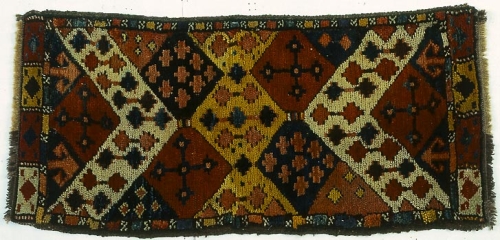
Eureka! Could
this be the model for The "Tarantula Beshir"? notice the similarity of the
rosettes in the compartments of this Kirghiz
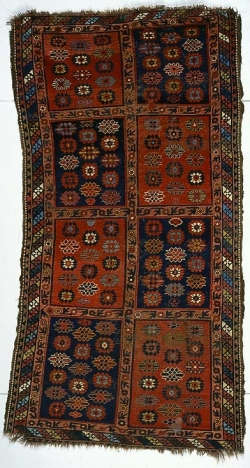
to those in the
"Tarantula Beshir" border.

Dave
Posted by Stephen Louw on 01-10-2005 09:15 AM:
Dave --
Very interesting detective work indeed. Thanks for all the
effort.
Regards
Stephen
Posted by David R.E. Hunt on 01-11-2005 06:23 PM:
Temirjin Gul?
Stephen and All
Thanks, but the pleasure is mine. This type of
computer research just seems to sear the details into memory. Might come in
handy some day, but with two little ones, at present I am somewhat financially
embarrased. 
Find
below some photos of a Timurid (copper/brass?) vessel, not likely period, but
just as with rugs some of these designs never seem to change. Was sold to me as
antique, and does seem to have some age, but I really don't know. Perhaps some
of our readers might be better aquainted?
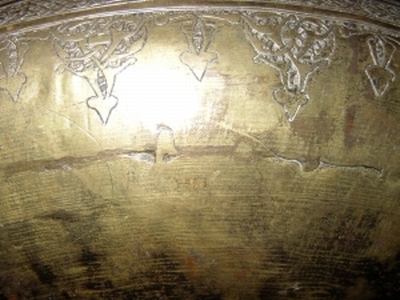
This photo is of the
underside, showing the concentric rings and the seam where the two pieces, top
and base were joined.
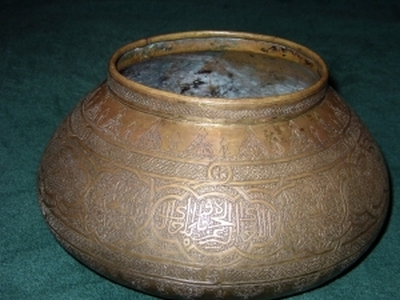
Here we have a view from the front,and about 12 inches
across. Detailed, but I don't know enough to rate. I didn't pay much, so am
satisfied with what I got.
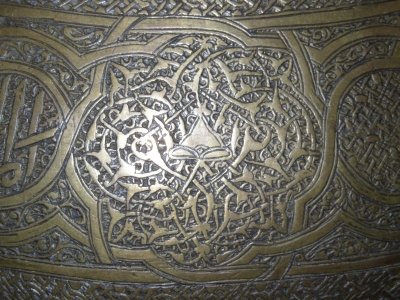
Could this be the octagon
(5cm./ 2 in.), based upon the large scale octagon patterns of the earlier Arab
period of Islamic history( follow this Link and
this Link to a discussion of this topic) which seems to have
launched a thousand imitations, from Mamluk
to Holbein to Kazhak
and Turkmen (temirjen gols?)? Notice the Timurid cap at the
junction of the islamis. This same type of scrolling is found on book covers of
the Mamluk period,
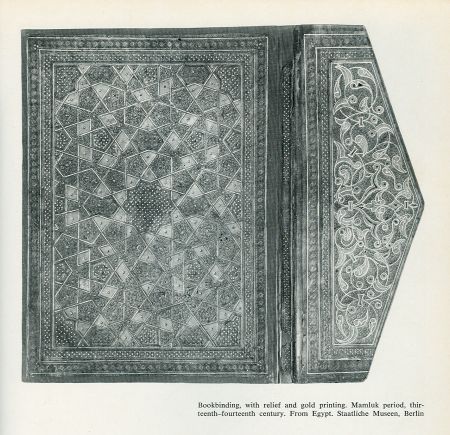
yet no
curvilinear carpet designs?
Dave
Posted by David R.E. Hunt on 01-14-2005 11:47 AM:
Mention of Prayer rug exports
All
Find below a short passage from Kalter regarding history and
trade in Turkestan
Only in the 9th century did independant Islamic
states emerge in Turkestan, at first still formally dependant on the court of
the (Arab) Caliph. The most important of these states, culturally as well as
economically, was the Samanid Empire (874 - 999). The Samanid's capital was
Bukhara, their most important governor's seat was
Nishapur.
and,
As documented by tens of thousands of Samanid
coins found in Scandanavia, but also a few scattered ones in Central Europe,
Samanid trade, passing via the Volga basin, reached nearly the whole of europe.
The list of export goods made up by the Arab geographer Mukadasi in the 10th
century (Brentjes 1976), is long and impressive. His (incomplete) list
comprises: rugs and prayer rugs from Bukhara and Samarkand, fine cloths
and weavings made from wool, cotton, and silk, soap, makeup, consecration oil,
bows that could only be bent by the strongest men, swords, armour,
stirrups,fittings, saddles,quivers, tents, rasins, sesame, nuts, honey, sheep,
cattle, horses and hawks, iron, sulfer, copper.
They have been
exporting these rugs for a long time.
Find below an example of this
highly regarded Samanid pottery, viewed from the base and bearing the
inscription, in highly stylized letters,"Frugality is a Symptom of Poverty" and
follow the link to discusion of Early Islamic Ceramics
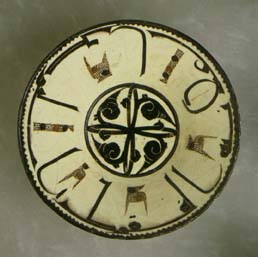
Dave




 ) I think the graphic impact of the
"tarantula" devices and the alternation of ground color is very
effective.
) I think the graphic impact of the
"tarantula" devices and the alternation of ground color is very
effective.
 .
.





















 ? this is because it is absolutly
vital to read the faster as possible the intentions on the face of the
individual you have in front of you
? this is because it is absolutly
vital to read the faster as possible the intentions on the face of the
individual you have in front of you  . The corporeal communication is priority holder over the oral
communication. This is true even with primitive animals and overspread in all
mamalian creatures.
. The corporeal communication is priority holder over the oral
communication. This is true even with primitive animals and overspread in all
mamalian creatures.

































































